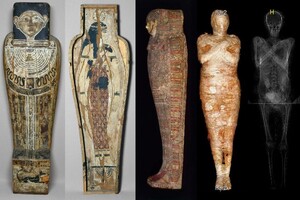The disease probably caused the woman's death.

Polish scientists studying the remains of the famous Egyptian < strong>“pregnant mummy”, found out the probable cause of death of an ancient woman. After studying her skull, researchers discovered cancer in a resident of Ancient Egypt, reports IFLScience.
In the 19th and 20th centuries, scientists assumed that the mummy belonged to a male priest. But scientists from the Warsaw Mummy Project found out that she is actually female. Later, it became clear that she is the first known example of a mummy of a pregnant woman.
Read also: Archaeologists found mummies of sacrificed children in Peru
Further research allowed the authors of the project to determine, < strong>how a fetus was able to survive in a woman's body.
Project scientists also admitted that they were often asked about how this young woman died, so they decided to find out. A scan of the woman's skull revealed unusual bone changes that indicated she had suffered from cancer.
In particular, marks on the skull indicated that the ancient woman suffered from nasopharyngeal cancer, a rare type of cancer that affects part of the throat , located between the back of the nose and mouth.
“The CT scan shows a small pathological change about 7 millimeters in diameter, a rounded mass surrounding an empty space, in the bone behind the left orbit. Most likely, this is a change caused by a tumor, possibly a metastatic cell,” said study authors Wojciech Eismond and Marjena Ozarek-Schielke.
Scientists also noted that similar changes in the skull occur, in particular, due to adenoma. At the same time, they will be able to get an accurate idea of the type of tumor thanks to histopathological tests. The researchers also found large cavities in the facial bones, including the nasal cavity, maxillary sinuses, and palatal part of the maxillary bones. And these changes correspond to nasopharyngeal cancer in modern patients.
To confirm the diagnosis, scientists need to study the mummy's tissues. The Warsaw Mummy Project team believes that oncologists could identify the “molecular signatures” of cancer found in the mummy and then compare them to current types of cancer. This could provide important data on the evolution of cancer.
The Warsaw Mummy Project was launched in 2015 by a team of bioarchaeologists from the University of Warsaw. In April 2021, scientists published an article in which they described the first case of finding a mummy of a pregnant woman with a mummified fetus in her womb.
Currently, the mummy is on display in the National Museum in Warsaw. For a long time it was believed to belong to Hor-Jehuti, the high priest of Amun in the time of Ahmose I, who lived at the beginning of the 18th dynasty (1539 – 1292 BC). But in 2016, the experts of the project stated that it is actually the mummy of a pregnant woman who died at 26-30 weeks of pregnancy and was embalmed.




